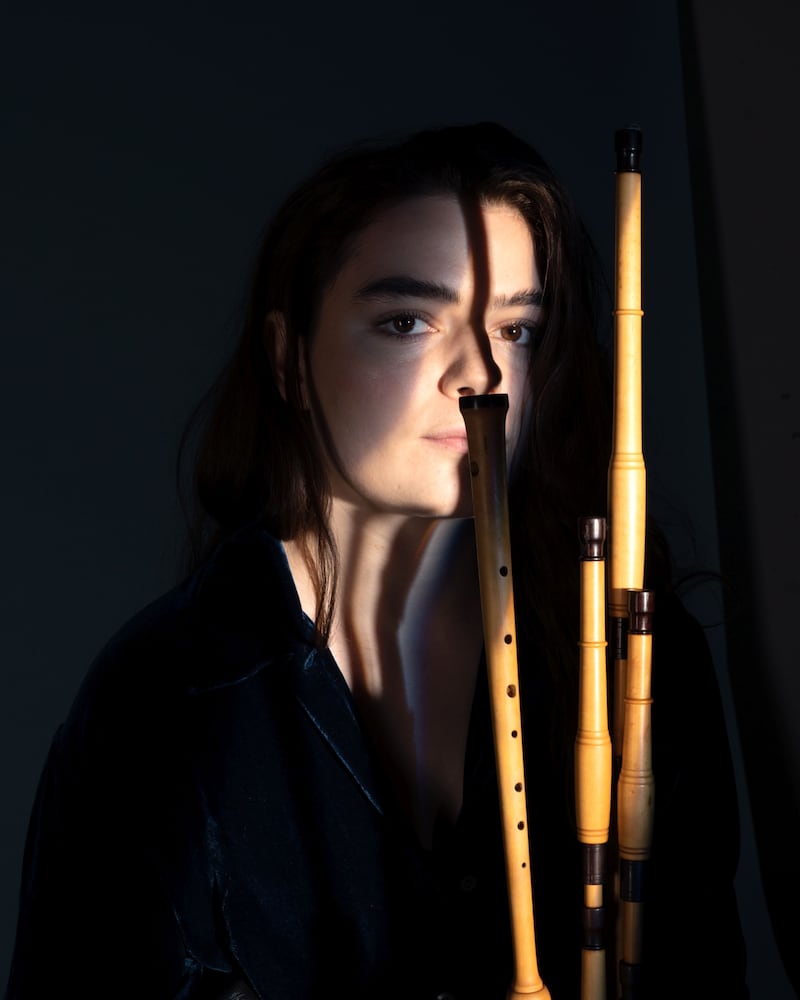Brìghde Chaimbeul’s big pop moment arrives 28 minutes into the new album by the avant-garde megastar Caroline Polachek. There, on the song Blood and Butter, Polachek’s breathy vocal gives way to a haunting solo by Chaimbeul, playing the Scottish border pipes.
It’s an arresting highlight of what is sure to go down as one of the year’s best records, the spectral pop interwoven with the ghostly drone of the pipes. Imagine the best possible version of the Chieftains jamming with Lady Gaga – then crank the melancholy and melody all the way up.
“It was unexpected. We weren’t in touch before that or anything. She came across my music on Spotify playlists. And wanted a pipe solo on her track,” says Chaimbeul, who grew up on the Isle of Skye, in Scotland, and is now based in Northern Ireland.
Polachek subsequently invited the 24-year-old to join her at Hammersmith Apollo, in London. The Scottish piper is a Trojan tourer and has graced Other Voices, in Dingle, and the Celtic Connections festival in Glasgow. (She’s also about to go on a short Irish tour that will take in dates in Cork, Limerick and Clare.) Going on stage with a pop star was new, however. It also came at a busy moment for the musician, who has also just released her breathtakingly eerie second LP, Carry Them With Us.
READ MORE
“It was obviously a lot more people than at my average gig,” she says. “The energy and the noise – it was very electric. Caroline is an amazing performer as well. To watch that was great. The pipes come in on the song at a great moment. After that, I had interviews in Dazed and Stereogum – mainstream magazines. They were asking questions about the pipes. I don’t think that would have happened otherwise.”
The press regarded having a Scottish pipe player on Polachek’s album Desire, I Want to Turn into You as fresh proof of the quirkiness of the American artist, whose repertoire is full of avant-garde flourishes. For Chaimbeul, it was an opportunity to put a spotlight on the border pipes and on her signature instrument, the Scottish smallpipes, a kind of cousin once removed of the uilleann pipes.
“Scottish smallpipes were revived in the late 1980s and 1990s in Scotland,” she says. “They’re still relatively new. Obviously, the big Highland pipes are well known. They’ve overshadowed [piping] for so long. With the Scottish smallpipes, you have the octave drones which are normal to most pipes. Uniquely with these, they have a second drone – which means it has a slightly fuller drone sound. The way I like to create my music is concentrated on the drones. It’s so important and unique to the pipes: it should be up the front and leading the arrangement.”

Chaimbeul grew up on the Sleat peninsula, on the southern edge of the Skye, where she was educated in Scottish Gaelic. Today, she lives just outside Belfast. She discovered the pipes at school and was inspired by the great traditional musician and storyteller Rona Lightfoot (who appeared on Chaimbeul’s first record).
To the ancient, she brings something modern. The droning aspect of her playing calls to mind not only traditional music but also more experimental artists such as Sarah Davachi and Anna Von Hausswolff. It also marks her out as a fellow traveller of Lankum, the Dublin group, whose output has a similarly mediative, even ominous quality. (Both acts are signed to Geoff Travis’s River Lea label.)
“They’re obviously inspired by the pipes as well. With Ian [Lynch] being the piper, that’s in their minds. I worked with Radie [Peat, the Lankum vocalist] on my first album too. She’s brilliant.”
[ Wild Youth and others cut ties with creative director ahead of EurovisionOpens in new window ]
Sleat is a small community perched, or so it can feel on a long, dark winter’s night, on the edge of the world. Chaimbeul isn’t consciously influenced by the landscape. Still, some of the starkness has seeped into her writing.
“With the traditional tunes and the songs, a lot of the time they have a connection to a certain place. Or, a song is about a certain area. For example, Pìobaireachd nan Eun, on the album, the first melody is a song from Skye. It’s meant to be the song that a swan sung on Loch Chaluim Chille, which is a loch that is drained now but, years ago in the 1800s, was up on the north end of Skye. You always have a particular connection to specific areas. It’s all part of the bigger picture.”
Bagpipes have often been used as a punchline – a Scottish caricature alongside kilts and haggis. Chaimbeul says things are changing; it helps that stars such as Polachek are spotlighting the instrument. Still, cliches endure. “There’s a very strong piping culture in the Highlands. Of course, in the mainstream media, there is always this stereotype.”
She is looking forward to touring Ireland. Her audiences are a diverse bunch. There are trad connoisseurs but also techno fans and those who simply like to lose themselves in the otherness of her music. “You get trad heads and people who are into really experimental sounds. And, often, electronica fans. The smallpipe has a certain electronic sound. My audience is varied – from your typical piper to a death-metal fan in leather outfits.”
Carry Them With Us is out now. Brìghde Chaimbeul plays Baltimore Fiddle Fair with Aidan O’Rourke on Thursday, May 4th; the Record Room, Limerick; on Friday, May 19th; and Courthouse Gallery & Studios, Ennistymon, Co Clare, on Saturday, May 20th















